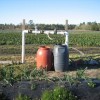
More and more farmers are growing small crops of fruits and vegetables for specialty local markets. They commonly grow several crops at different stages of development at the same time so they have a variety of produce to sell to customers. This forces farmers to make several fertilizer calculations because of their diverse crop demands, because water and nutrient requirements vary according to the crop and stage of development. This 7-page fact sheet helps growers correctly interpret fertilizer recommendations and calculate accurate fertilizer amounts to be used based on crop nutrient requirements. Written by Jim DeValerio, David Nistler, Robert Hochmuth, and Eric Simonne, and published by the UF Department of Horticultural Sciences, October 2012.
http://edis.ifas.ufl.edu/hs1206
Author: dihagan
Cassia javanica, Pink and White Shower (FOR297/FR365)
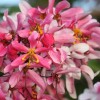 Cassia javanica is planted primarily as a decorative shade tree. Many people consider pink and white shower to be aesthetically pleasing because of its pink and white blooms that emerge during the summer months. Because its leafless season is so short, it can be a good shade tree throughout the year. Its rapid growth rate makes it an ideal tree for homeowners looking to increase their tree cover. And its natural resistance to pests increases its desirability as a landscape tree that is commonly used as an ornamental street tree. This 2-page fact sheet was written by Michael G. Andreu, Melissa H. Friedman, and Robert J. Northrop, and published by the UF Department of School of Forest Resources and Conservation, July 2012.
Cassia javanica is planted primarily as a decorative shade tree. Many people consider pink and white shower to be aesthetically pleasing because of its pink and white blooms that emerge during the summer months. Because its leafless season is so short, it can be a good shade tree throughout the year. Its rapid growth rate makes it an ideal tree for homeowners looking to increase their tree cover. And its natural resistance to pests increases its desirability as a landscape tree that is commonly used as an ornamental street tree. This 2-page fact sheet was written by Michael G. Andreu, Melissa H. Friedman, and Robert J. Northrop, and published by the UF Department of School of Forest Resources and Conservation, July 2012.
http://edis.ifas.ufl.edu/fr365
What Do You See? Healthy Dating That Leads to Healthy Marriage (FCS2322/FY1338)
 Albert Einstein offered this perspective on dating and romantic relationships: “Any man who can drive safely while kissing a pretty girl is simply not giving the kiss the attention it deserves.” Dating relationships are the building blocks for healthy marriage relationships. To give them “the attention they deserve,” use different perspectives to help see why healthy dating can lead to healthy marriages or why unhealthy dating can lead to unhealthy marriages and divorce. This 4-page fact sheet was written by Victor W. Harris and Ginny Hinton, and published by the UF Department of Family Youth and Community Sciences, September 2012.
Albert Einstein offered this perspective on dating and romantic relationships: “Any man who can drive safely while kissing a pretty girl is simply not giving the kiss the attention it deserves.” Dating relationships are the building blocks for healthy marriage relationships. To give them “the attention they deserve,” use different perspectives to help see why healthy dating can lead to healthy marriages or why unhealthy dating can lead to unhealthy marriages and divorce. This 4-page fact sheet was written by Victor W. Harris and Ginny Hinton, and published by the UF Department of Family Youth and Community Sciences, September 2012.
http://edis.ifas.ufl.edu/fy1338
Healthy Living: Beating Barriers to Physical Activity (FCS8818/FY883)
 Being active can help you function better and maintain your independence. It also can reduce your risk for getting some diseases, such as diabetes, and help you manage health problems you may already have. If you’re not active, what’s stopping you from getting started? Read on to learn how to overcome some common barriers! This 2-page fact sheet was written by Jennifer Hillan and Linda B. Bobroff, and published by the UF Department of Family Youth and Community Sciences, September 2012.
Being active can help you function better and maintain your independence. It also can reduce your risk for getting some diseases, such as diabetes, and help you manage health problems you may already have. If you’re not active, what’s stopping you from getting started? Read on to learn how to overcome some common barriers! This 2-page fact sheet was written by Jennifer Hillan and Linda B. Bobroff, and published by the UF Department of Family Youth and Community Sciences, September 2012.
http://edis.ifas.ufl.edu/fy883
Pepper Fruit Fly Atherigona orientalis (Schiner) (Insecta: Diptera: Muscidae) (EENY539/IN948)
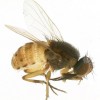 Although it is commonly referred to as the pepper fruit fly or tomato fruit fly, Atherigona orientalis is not a true fruit fly in the family Tephritidae, but rather a member of the Muscidae, the same family to which the common house fly belongs. It is found in most tropical and subtropical areas of the world and is usually considered a secondary pest or “trash fly.” But it can sometimes be a primary pest of certain agricultural crops, most notably plants in the family Solanaceae. This 4-page fact sheet was written by Kenneth L. Hibbard and William A. Overholt, and published by the UF Department of Entomology and Nematology, September 2012.
Although it is commonly referred to as the pepper fruit fly or tomato fruit fly, Atherigona orientalis is not a true fruit fly in the family Tephritidae, but rather a member of the Muscidae, the same family to which the common house fly belongs. It is found in most tropical and subtropical areas of the world and is usually considered a secondary pest or “trash fly.” But it can sometimes be a primary pest of certain agricultural crops, most notably plants in the family Solanaceae. This 4-page fact sheet was written by Kenneth L. Hibbard and William A. Overholt, and published by the UF Department of Entomology and Nematology, September 2012.
http://edis.ifas.ufl.edu/in948
Black-tailed Mosquito Culiseta melanura (Coquillett) (Insecta: Diptera: Culicidae) (EENY536/IN950)
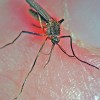 The black-tailed mosquito is unusual because it overwinters as larvae while most mosquito species overwinter as either adults or eggs. Culiseta melanura is important because of its role in the transmission cycle of eastern equine encephalitis virus and potentially West Nile virus: because adult female Culiseta melanura primarily take their blood meals from birds, they are responsible for transmitting eastern equine encephalitis virus between birds. This 6-page fact sheet was written by Eva Buckner, Angelique Showman, and C. Roxanne Connelly, and published by the UF Department of Entomology and Nematology, September 2012.
The black-tailed mosquito is unusual because it overwinters as larvae while most mosquito species overwinter as either adults or eggs. Culiseta melanura is important because of its role in the transmission cycle of eastern equine encephalitis virus and potentially West Nile virus: because adult female Culiseta melanura primarily take their blood meals from birds, they are responsible for transmitting eastern equine encephalitis virus between birds. This 6-page fact sheet was written by Eva Buckner, Angelique Showman, and C. Roxanne Connelly, and published by the UF Department of Entomology and Nematology, September 2012.
http://edis.ifas.ufl.edu/in950
Florida Scorpionfly, Panorpa floridana Byers (Insecta: Mecoptera: Panorpidae) (EENY538/IN949)
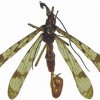 Have you seen this insect? No living individuals of Panorpa floridana ever have been observed. Knowledge of this species of scorpionfly is limited to five specimens from Alachua and Clay counties in northern peninsular Florida, the last one collected in 1982. This 4-page fact sheet was written by Louis A. Somma and James C. Dunford, and published by the UF Department of Entomology and Nematology, September 2012.
Have you seen this insect? No living individuals of Panorpa floridana ever have been observed. Knowledge of this species of scorpionfly is limited to five specimens from Alachua and Clay counties in northern peninsular Florida, the last one collected in 1982. This 4-page fact sheet was written by Louis A. Somma and James C. Dunford, and published by the UF Department of Entomology and Nematology, September 2012.
http://edis.ifas.ufl.edu/in949
Healthy Eating: Folate (FCS8560/FY055)
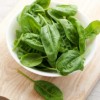 Folate is one of the B vitamins. Our bodies use folate to make new cells. Folate is especially important for women of childbearing age, pregnant and nursing women, growing children, and older people. If you don’t get enough folate in your diet, you could get anemia. You also could be at higher risk for heart disease, stroke, cancer, or memory problems. This 1-page large print fact sheet was written by Linda B. Bobroff, and published by the UF Department of Family Youth and Community Sciences, September 2012.
Folate is one of the B vitamins. Our bodies use folate to make new cells. Folate is especially important for women of childbearing age, pregnant and nursing women, growing children, and older people. If you don’t get enough folate in your diet, you could get anemia. You also could be at higher risk for heart disease, stroke, cancer, or memory problems. This 1-page large print fact sheet was written by Linda B. Bobroff, and published by the UF Department of Family Youth and Community Sciences, September 2012.
http://edis.ifas.ufl.edu/fy055
Spring Viremia of Carp (VM142/VM106)
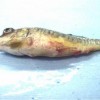 Spring viremia of carp is a viral disease that can cause significant mortality in several carp species including the common carp. It was reported in koi and feral carp in the United States for the first time in 2002. Diagnosis in farm raised fish in the U.S. may result in quarantine of the infected fish and depopulation. This 5-page fact sheet is intended to inform veterinarians, biologists, culturists, and hobbyists about Spring viremia of carp. Written by Barbara D. Petty, Ruth Francis-Floyd, and Roy P.E. Yanong, and published by the UF Department of Fisheries and Aquatic Sciences, August 2012.
Spring viremia of carp is a viral disease that can cause significant mortality in several carp species including the common carp. It was reported in koi and feral carp in the United States for the first time in 2002. Diagnosis in farm raised fish in the U.S. may result in quarantine of the infected fish and depopulation. This 5-page fact sheet is intended to inform veterinarians, biologists, culturists, and hobbyists about Spring viremia of carp. Written by Barbara D. Petty, Ruth Francis-Floyd, and Roy P.E. Yanong, and published by the UF Department of Fisheries and Aquatic Sciences, August 2012.
http://edis.ifas.ufl.edu/vm106
Hurricane-Damaged Palms in the Landscape: Care after the Storm (ENH1204/EP465)
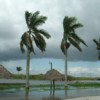 While many palm species are adapted to windstorms, a hurricane can damage even the most tolerant palms. This 3-page fact sheet provides suggestions about what to do after a windstorm has occurred once it is safe to venture outside to care for the landscape.
While many palm species are adapted to windstorms, a hurricane can damage even the most tolerant palms. This 3-page fact sheet provides suggestions about what to do after a windstorm has occurred once it is safe to venture outside to care for the landscape.
Written by Monica L. Elliott and Timothy Broschat, and published by the UF Department of Environmental Horticulture, September 2012.
http://edis.ifas.ufl.edu/ep465
Alternatives to Synthetic Herbicides for Weed Management in Container Nurseries (ENH1203/EP464)
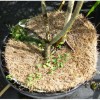 Weed management is one of the most critical and costly aspects of container nursery production. This is most effectively achieved through preventative practices, primarily with preemergent herbicides. But there are valid reasons for managing weeds with alternatives to synthetic herbicides, including sanitation, exclusion, prevention, hand weeding, mulching, and the use of cover crops, heat, and nonsynthetic herbicides. This 6-page fact sheet was written by Gary W. Knox, Matthew Chappell, and Robert H. Stamps, and published by the UF Department of Environmental Horticulture, September 2012.
Weed management is one of the most critical and costly aspects of container nursery production. This is most effectively achieved through preventative practices, primarily with preemergent herbicides. But there are valid reasons for managing weeds with alternatives to synthetic herbicides, including sanitation, exclusion, prevention, hand weeding, mulching, and the use of cover crops, heat, and nonsynthetic herbicides. This 6-page fact sheet was written by Gary W. Knox, Matthew Chappell, and Robert H. Stamps, and published by the UF Department of Environmental Horticulture, September 2012.
http://edis.ifas.ufl.edu/ep464
UF-T3 and UF-T4: Two Sterile Lantana camara Varieties (ENH1202/EP463)
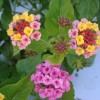 Lantana camara plants are valued for their bright flower color, butterfly attraction, tolerance to harsh environmental conditions, low maintenance requirements, and ease of propagation and production. But many existing varieties can be weedy or invasive when grown in tropical and subtropical regions. So in 2004, UF/IFAS started a program to develop sterile L. camara varieties with little to no invasive potential.
Lantana camara plants are valued for their bright flower color, butterfly attraction, tolerance to harsh environmental conditions, low maintenance requirements, and ease of propagation and production. But many existing varieties can be weedy or invasive when grown in tropical and subtropical regions. So in 2004, UF/IFAS started a program to develop sterile L. camara varieties with little to no invasive potential.
This 8-page fact sheet introduces the recently released UF-T3 and UF-T4 lantana varieties that have resulted from these breeding, selection, and testing efforts. Written by Zhanao Deng, David M. Czarnecki II, Sandra B. Wilson, Gary W. Knox, and Rosanna Freyre, and published by the UF Department of Environmental Horticulture, August 2012.
http://edis.ifas.ufl.edu/ep463
MyPyramid for Kids (FAR8047/FM356)
 “In 2005, MyPyramid for Kids was launched with the positive slogan ‘Eat Right. Exercise. Have Fun.’ This new resource, targeting children ages six to eleven, is an excellent tool to help children improve their food and activity choices.” This 2-page Family Album Radio transcript was written by Ariadna M. Rodriguez and Linda Bobroff, and published by the UF Department of Family Youth and Community Sciences, August 2012.
“In 2005, MyPyramid for Kids was launched with the positive slogan ‘Eat Right. Exercise. Have Fun.’ This new resource, targeting children ages six to eleven, is an excellent tool to help children improve their food and activity choices.” This 2-page Family Album Radio transcript was written by Ariadna M. Rodriguez and Linda Bobroff, and published by the UF Department of Family Youth and Community Sciences, August 2012.
http://edis.ifas.ufl.edu/fm356
The Effects of Caffeine on Lactation (FAR0423/FM354)
 “Human milk is the preferred food for infants, with exceptional physiological benefits not only for the baby but for the mother as well. Mothers need to be aware, though, that many substances that they consume are excreted in breast milk and can profoundly affect the composition and adequacy of her breastmilk. Even caffeine, which many of us consume on a daily basis in our coffee, tea, cola drinks and chocolate, finds its way into breast milk.” This 2-page Family Album Radio transcript was written by Ashley Orynich and Linda Bobroff, and published by the UF Department of Family Youth and Community Sciences, August 2012.
“Human milk is the preferred food for infants, with exceptional physiological benefits not only for the baby but for the mother as well. Mothers need to be aware, though, that many substances that they consume are excreted in breast milk and can profoundly affect the composition and adequacy of her breastmilk. Even caffeine, which many of us consume on a daily basis in our coffee, tea, cola drinks and chocolate, finds its way into breast milk.” This 2-page Family Album Radio transcript was written by Ashley Orynich and Linda Bobroff, and published by the UF Department of Family Youth and Community Sciences, August 2012.
http://edis.ifas.ufl.edu/fm354
Renter’s Insurance (FAR5007/FM382)
 “Whether you’re a family living in a rental house or apartment, or a parent whose children are in a rental situation, one of the costs that people tend to forget or ignore is renter’s insurance. But according to consumer science researchers, everyone renting an apartment or a house should have renter’s insurance. It will protect you and your family against losses from disasters such as hurricanes and fire.” This 2-page Family Album Radio transcript was written by Mary Harrison and Donna Davis, and published by the UF Department of Family Youth and Community Sciences, August 2012.
“Whether you’re a family living in a rental house or apartment, or a parent whose children are in a rental situation, one of the costs that people tend to forget or ignore is renter’s insurance. But according to consumer science researchers, everyone renting an apartment or a house should have renter’s insurance. It will protect you and your family against losses from disasters such as hurricanes and fire.” This 2-page Family Album Radio transcript was written by Mary Harrison and Donna Davis, and published by the UF Department of Family Youth and Community Sciences, August 2012.
http://edis.ifas.ufl.edu/fm382
Registration and Licensure of Nutrition Professionals in Florida (FCS8765/FY690)
 Registration and licensure of nutrition professionals exist to protect the public from people who are not qualified to practice as nutrition professionals, just as licensure of physicians protects the public from people who are not qualified to practice medicine. This 3-page fact sheet provides information about dietetic registration (a national credential) and licensure (a state-specific license). Florida has three credentials that allow people to legally practice as a nutrition or dietetics professional: Registered Dietitian (RD), Licensed Dietitian/Nutritionist (LD/N), and Licensed Nutrition Counselor (LNC). Written by Linda B. Bobroff, and published by the UF Department of Family Youth and Community Sciences, September 2012.
Registration and licensure of nutrition professionals exist to protect the public from people who are not qualified to practice as nutrition professionals, just as licensure of physicians protects the public from people who are not qualified to practice medicine. This 3-page fact sheet provides information about dietetic registration (a national credential) and licensure (a state-specific license). Florida has three credentials that allow people to legally practice as a nutrition or dietetics professional: Registered Dietitian (RD), Licensed Dietitian/Nutritionist (LD/N), and Licensed Nutrition Counselor (LNC). Written by Linda B. Bobroff, and published by the UF Department of Family Youth and Community Sciences, September 2012.
http://edis.ifas.ufl.edu/fy690
Cactus Moth, Cactoblastis cactorum (Berg) (Insecta: Lepidoptera: Pyralidae) (EENY056/IN213)
 Since its arrival in the Florida Keys in 1989, this invasive species has become a serious threat to the diversity and abundance of Opuntia cactus in North America. The spread of this moth raises concerns about harm to rare opuntioid species (prickly pear and related cacti), the endangerment of wild opuntioids in the southwestern United States and Mexico and the consequent effects on entire desert ecosystems and economic hardship for communities in Mexico that cultivate and sell Opuntia. This 5-page fact sheet was written by D. H. Habeck, F. D. Bennett, and Christine Miller, and published by the UF Department of Entomology and Nematology, September 2012.
Since its arrival in the Florida Keys in 1989, this invasive species has become a serious threat to the diversity and abundance of Opuntia cactus in North America. The spread of this moth raises concerns about harm to rare opuntioid species (prickly pear and related cacti), the endangerment of wild opuntioids in the southwestern United States and Mexico and the consequent effects on entire desert ecosystems and economic hardship for communities in Mexico that cultivate and sell Opuntia. This 5-page fact sheet was written by D. H. Habeck, F. D. Bennett, and Christine Miller, and published by the UF Department of Entomology and Nematology, September 2012.
http://edis.ifas.ufl.edu/in213
Earthworm, suborder Crassiclitellata, cohort Terrimegadrili (Jamieson, 1988) (EENY532/IN946)
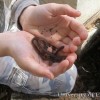 Like insects, earthworms are among the animals most frequently encountered by many Floridians. Our kids play with them, dissect them in middle school biology, we fish with them, they crawl across our sidewalks and live in our flower pots. Despite this, their ecological and economic importance often goes unrecognized. Earthworms have several important ecological roles. Additionally, some species are used commercially for bait, animal feed, environmental remediation, and composting. This 6-page fact sheet was written by William T. Crow, and published by the UF Department of Entomology and Nematology, September 2012.
Like insects, earthworms are among the animals most frequently encountered by many Floridians. Our kids play with them, dissect them in middle school biology, we fish with them, they crawl across our sidewalks and live in our flower pots. Despite this, their ecological and economic importance often goes unrecognized. Earthworms have several important ecological roles. Additionally, some species are used commercially for bait, animal feed, environmental remediation, and composting. This 6-page fact sheet was written by William T. Crow, and published by the UF Department of Entomology and Nematology, September 2012.
http://edis.ifas.ufl.edu/in946
An Asian Ground Beetle, Mochtherus tetraspilotus (MacLeay) (Coleoptera: Carabidae: Lebiini) (EENY533/IN951)
 Mochtherus tetraspilotus (MacLeay) was first detected in southern Florida in 1992. Since then specimens have been collected in Gainesville and at Archbold Biological Station in Highlands County. Adult members of this group of Carabidae are known to be predators. The impact of this species on our native species remains to be determined, as does the source of introduction. Its rapid spread in Florida suggests that it may soon be found throughout the Gulf States. This 2-page fact sheet was written by Paul M. Choate, and published by the UF Department of Entomology and Nematology, September 2012.
Mochtherus tetraspilotus (MacLeay) was first detected in southern Florida in 1992. Since then specimens have been collected in Gainesville and at Archbold Biological Station in Highlands County. Adult members of this group of Carabidae are known to be predators. The impact of this species on our native species remains to be determined, as does the source of introduction. Its rapid spread in Florida suggests that it may soon be found throughout the Gulf States. This 2-page fact sheet was written by Paul M. Choate, and published by the UF Department of Entomology and Nematology, September 2012.
http://edis.ifas.ufl.edu/in951
Guidelines and Management Practices for Artificial Reef Siting, Use, Construction, and Anchoring in Southeast Florida (TP176/SG101)
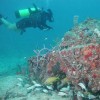 Coral reefs are one of southeast Florida’s most highly valued ocean resources. Despite their economic and ecological importance, they continue to face damage and destruction from human activity. “Artificial reefs” can help restore damaged coral reefs or mitigate their loss. Hundreds these natural and man-made structures have been deployed in southeast Florida coastal waters over the last 30 years. However, construction practices, design features and use patterns associated with this reef-building all have the potential to affect coral ecosystems. This 162-page guide describes artificial reef science and technology as a means of helping practitioners with varied backgrounds, skills and experience achieve responsible and sustainable reef development. Written by William Lindberg and William Seaman, and published by the UF Florida Sea Grant Program, June 2012.
Coral reefs are one of southeast Florida’s most highly valued ocean resources. Despite their economic and ecological importance, they continue to face damage and destruction from human activity. “Artificial reefs” can help restore damaged coral reefs or mitigate their loss. Hundreds these natural and man-made structures have been deployed in southeast Florida coastal waters over the last 30 years. However, construction practices, design features and use patterns associated with this reef-building all have the potential to affect coral ecosystems. This 162-page guide describes artificial reef science and technology as a means of helping practitioners with varied backgrounds, skills and experience achieve responsible and sustainable reef development. Written by William Lindberg and William Seaman, and published by the UF Florida Sea Grant Program, June 2012.
http://edis.ifas.ufl.edu/sg101